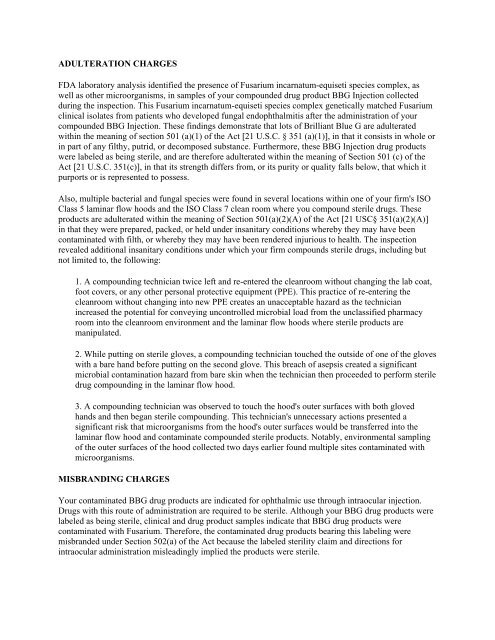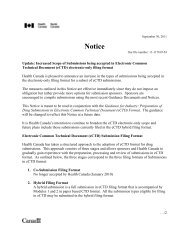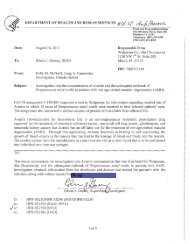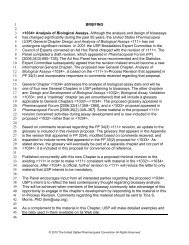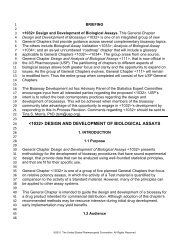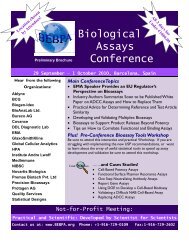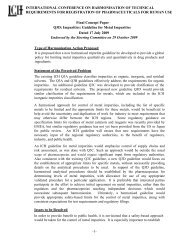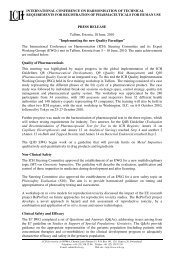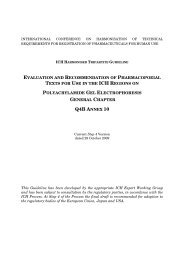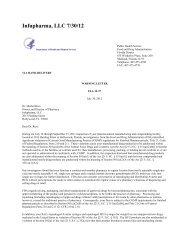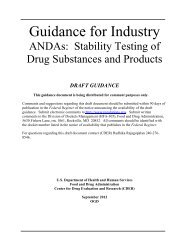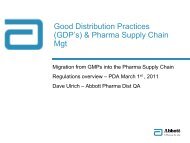Warning Letter - IPQ
Warning Letter - IPQ
Warning Letter - IPQ
You also want an ePaper? Increase the reach of your titles
YUMPU automatically turns print PDFs into web optimized ePapers that Google loves.
ADULTERATION CHARGES<br />
FDA laboratory analysis identified the presence of Fusarium incarnatum-equiseti species complex, as<br />
well as other microorganisms, in samples of your compounded drug product BBG Injection collected<br />
during the inspection. This Fusarium incarnatum-equiseti species complex genetically matched Fusarium<br />
clinical isolates from patients who developed fungal endophthalmitis after the administration of your<br />
compounded BBG Injection. These findings demonstrate that lots of Brilliant Blue G are adulterated<br />
within the meaning of section 501 (a)(1) of the Act [21 U.S.C. § 351 (a)(1)], in that it consists in whole or<br />
in part of any filthy, putrid, or decomposed substance. Furthermore, these BBG Injection drug products<br />
were labeled as being sterile, and are therefore adulterated within the meaning of Section 501 (c) of the<br />
Act [21 U.S.C. 351(c)], in that its strength differs from, or its purity or quality falls below, that which it<br />
purports or is represented to possess.<br />
Also, multiple bacterial and fungal species were found in several locations within one of your firm's ISO<br />
Class 5 laminar flow hoods and the ISO Class 7 clean room where you compound sterile drugs. These<br />
products are adulterated within the meaning of Section 501(a)(2)(A) of the Act [21 USC§ 351(a)(2)(A)]<br />
in that they were prepared, packed, or held under insanitary conditions whereby they may have been<br />
contaminated with filth, or whereby they may have been rendered injurious to health. The inspection<br />
revealed additional insanitary conditions under which your firm compounds sterile drugs, including but<br />
not limited to, the following:<br />
1. A compounding technician twice left and re-entered the cleanroom without changing the lab coat,<br />
foot covers, or any other personal protective equipment (PPE). This practice of re-entering the<br />
cleanroom without changing into new PPE creates an unacceptable hazard as the technician<br />
increased the potential for conveying uncontrolled microbial load from the unclassified pharmacy<br />
room into the cleanroom environment and the laminar flow hoods where sterile products are<br />
manipulated.<br />
2. While putting on sterile gloves, a compounding technician touched the outside of one of the gloves<br />
with a bare hand before putting on the second glove. This breach of asepsis created a significant<br />
microbial contamination hazard from bare skin when the technician then proceeded to perform sterile<br />
drug compounding in the laminar flow hood.<br />
3. A compounding technician was observed to touch the hood's outer surfaces with both gloved<br />
hands and then began sterile compounding. This technician's unnecessary actions presented a<br />
significant risk that microorganisms from the hood's outer surfaces would be transferred into the<br />
laminar flow hood and contaminate compounded sterile products. Notably, environmental sampling<br />
of the outer surfaces of the hood collected two days earlier found multiple sites contaminated with<br />
microorganisms.<br />
MISBRANDING CHARGES<br />
Your contaminated BBG drug products are indicated for ophthalmic use through intraocular injection.<br />
Drugs with this route of administration are required to be sterile. Although your BBG drug products were<br />
labeled as being sterile, clinical and drug product samples indicate that BBG drug products were<br />
contaminated with Fusarium. Therefore, the contaminated drug products bearing this labeling were<br />
misbranded under Section 502(a) of the Act because the labeled sterility claim and directions for<br />
intraocular administration misleadingly implied the products were sterile.


